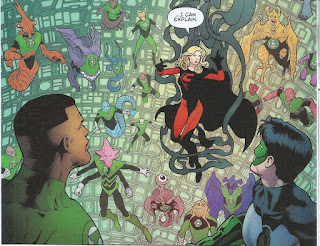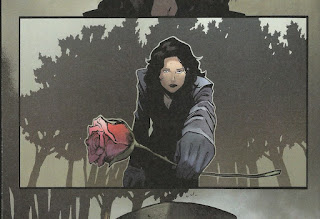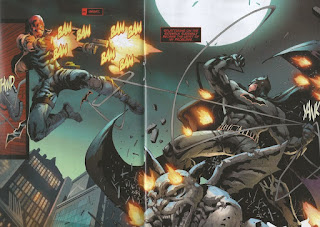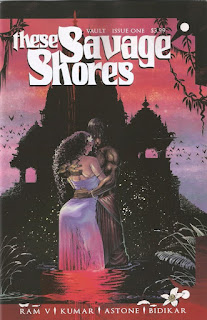Pick of the Brown Bag
October 10, 2018
by
Ray Tate
Welcome to the Pick of the Brown Bag, I’m Ray Tate your reviewer of the week’s best and worst comic books. Today, I peruse Albert Einstein Time Mason, Catwoman, Detective Comics, Project Superpowers, Red Hood and the Outlaws, Supergirl, These Savage Shores, Titans, Unbeatable Squirrel Girl, Wrong Earth and X-23. New capsules of the reviews can be found on Twitter: #PickoftheBrownBag.
Supergirl’s television season debut was pretty awesome. Melissa Benoist was in top form. The tete-a-tete between Alex Danvers and Brainiac Five added comedy in a story about prejudice and hatred. The premiere reintroduced Brenda Strong as the sharp and funny Lillian Luthor. Lilian ratted out two well-known miscreants from Superman mythology to Supergirl and her daughter Lena (Katie McGrath). David Harewood returned along with best Jimmy Olsen ever Mehcad Brooks. Lynda Carter classed up the joint as Madame President and new addition to the cast Nichole Maines is winning as Catco’s newest reporter. So how did the Supergirl book do this week. Not bad at all.
According to the New Coke, Krypton didn’t just explode because it formed around a neutron star; as brilliantly suggested by Professor James Kakalios in The Physics of Superheroes. It was murder.
Translation the little dead blue guy isn’t going to give Kara any straight answers. At least his reticence is perfectly in character for a Guardian.
So, it looks like Rogol Zaar the former owner of Kara’s axe is a kind of planetary hitman working for a group of conspirators known as the Circle. They decided to kill Krypton. The sixty-four dollar question of course is who comprises the Circle apart from the little dead blue guy?
This is really typical of faerie folk and scifi little blue guys. They send you off on a quest to get answers rather than give you a list of facts. Kara has a first obstacle to get over before even thinking of partaking the rest of the rally.
Supergirl broke into the Green Lantern Archives to acquire this information. Scant as it is. She loses the confession crystal during the battle against the Lanterns, but Kara has backup, in the form of a spectacular gift her cousin Superman lent to her.
As the battle ensues, the art of Kevin Maguire gains ever so much importance. The story by Marc Andreyko is a good one. Maguire gives it extra oomph. Turning innocuous moments into amazing ones.
That could have been a simple action scene, a mere display of power. Maguire though creates personality, wit and interconnection between heroes caught in a bad situation.
Andreyko comes to the fore with an unexpected but plausible ally that facilitates Kara’s escape from a whole planetful of Green Lanterns. These panels are also notable for the shifts in color always a pop to the eyes. Supergirl is a must for fans of the hero, science fiction pulp aficionados and admirers of Kevin Maguire’s illustration.
Project Superpowers examines the source of the heroes’ abilities acquired after being freed from Pandora’s Urn. For example, originally Miss Masque was an athlete and gun-wielding detective/crime fighter. She gained the ability to possess people.
Writer Rob Williams conceives a fascinating idea that also explains the latest attack the Superpowers parry, but that would be telling. So instead, we drop down to the more reviewable bits.
Williams demonstrates an ear for dialogue that unifies the team and speaks of its esteemed history. If you haven’t been paying attention. The Superpowers are public domain 1940s characters forged into a fighting force thematically similar to the Justice Society. As the Black Terror watches over the new American Spirit, his easy-going attitude shows that he’s familiar with the Spirit and knows the girl swathed in the flag is safe.
Williams turns his attention to the Silver Scarab and Samson.
Williams did his research on Samson. The 1940s fellow was indeed a descendent of the Biblical hero. Williams livens up the character for modern times by granting him an unwitting outrageous sense of humor.
Artist Sergio Davila imbues the illustration with power that suits the strong man. It’s breath-taking to see Samson in action. In ranking, Samson is a third tier character at best being inflated naturally by art and dialogue to first rate.
That same care can be seen in the Silver Scarab. Though loosely based on a 1940s figure, he’s a ninety-five percent original. Davila’s design is remarkable. He looks like an Art Deco creation come to life. Williams take on the character is unique with a more ethnic background and a different style of operating than more familiar armored and beetled heroes.
As the book draws to a conclusion, Williams unveils a nasty surprise. Davila in turn demonstrates that he can not only render the champions of the world but also body horror shocking in its appearance amongst a story that seems only be about traditional superhero styled good vs evil.
Both Titans and Red Hood deal with the aftermath of Dick Grayson being traumatized in Batman and two second tier characters being offed in Heroes in Crisis. I won’t divulge any crucial information about those books. So feel free to read the reviews knowing that you’re likely safe from spoilers.
TItans is easily the darker of the two. The story opens with Donna Troy visiting a grave. No. Not Dick’s grave. Dick’s not dead. Just screwy in the head.
A fateful encounter with the teen infused in power she couldn’t control catalyzed the old Dick’s passion in the new mission, and the Justice League agreed.
Dick before going screwy in the head
The Titans needed to pick up where the historical Teen Titans left off. Namely address teens in trouble.
It just happened that the trouble in this case resulted from the breaking of the Source Wall, in Metal or some other Big Stupid Event I didn’t read.
Titans explores the Emergent Crisis without Dick Grayson and whether or not they actually can. This is the very definition of a crossroads. All the Titans try to figure what to do next.
The Titans’ dilemma lies in Tyler Baines the first Emergent they encountered. Miss Martian is bedrock solid in her ethics.
Beast Boy’s desperate to save the kid and willing to go beyond the reasonable to do it. One’s over emotional. The other rational to a fault. Fortunately, they have an empath on the team who may just be able to mediate.
Raven suffers from her own malady, and Abnett uses that to extract a speech that’s truly one of the character’s best moments.
Ultimately, Donna steps up—possibly as the new Away Team leader—to voice the opinion Dick would have had were he not screwy in the head.
Given that writer Dan Abnett embraces scenarios that happened in three stories occurring outside of his purview, it’s a wonder that the Titans reads so well as it does. That’s really a testament of his skill.
Red Hood on the other hand is surprisingly optimistic and fun despite the deaths in Heroes in Crisis.
Jason Todd seemed to kill a Batman rogue on camera. As issues played out, DC decided that they needed this rogue. I agree with that. DC does need this particular rogue. He fills a niche. They tried to replace him twice since the New 52 and failed pretty miserably.
Nevertheless, Jason Todd tried to kill this Batman rogue really hard. In subsequent issues, the rogue got better despite being shot by Jason at point blank range. This kind of thing does happen. So, I have no qualms about the plausibility of the whole affair.
It was still a pretty darn unheroic thing to do and explains Batman beating the living tar out of surrogate son number two; forcing Jason to go on the run after he experienced some science fiction healing from Starfire’s advanced technology.
Moral of the story. When Batman really concentrates and beats the tar out of you, you don’t get up and walk way. Just think what Jason would have felt like if Batman hadn’t been holding back.
The current issue starts off with Jason leaving a message for one of his friends, but reels back to Jason in the midst of an investigation. He makes one of the mules his special friend for obvious reasons.
Things go south real fast, but Red Hood isn’t about that. Instead, it’s about Batman being a human being who despite dishing out that whupping loves his son to pieces.
Writer Scott Lobdell balances comedy and pathos in Red Hood. No explanation is needed for Batman knowing where Jason traveled, and when he arrives, and he announces himself in a way only Batman can. Because of my no-spoiler policy, you'll have to buy the book to catch the hilarious and fitting moment.
With the riff-raff quelled, Bruce has a heart-to-heart with Jason. He informs Jason of the tragedy that occurred in Heroes in Crisis, and also demonstrates the change in the weather resulting from Jason’s actions.
This however is mere updating. The important moments occur when Batman and Jason reconcile in genuinely moving moments.
I’ve said it before and I’ll say it again, Scott Lobdell loves Jason Todd. No idea why, but he’s turned Jason into something better than originally thought in either the pre-Crisis or the post-Crisis.
Juxtaposed against a trite flashback story, Catwoman visits her vegetable sister Maggie while writer Joelle Jones tries to pull a Tom King and fails because of the material she’s got to work with. In short. I’m out.
Introduced by Mindy Newell in the horrible Catwoman Year One, Maggie is a dumbass trope. She’s one side of the Madonna/Whore Complex often used to describe women. The idea is that there are two types and only two types of women. The title of this chauvinistic idea is self-explanatory.
Maggie is Selina’s heretofore unknown relative. She’s a double sister because she grows up to be a nun. In Dark Knight Returns, Frank Miller suggests Catwoman became a prostitute. In Batman Year One, Miller retroactively already made her a prostitute.
Catwoman Year One took that idea even farther and also debuted her pimp. You see? Maggie is the Madonna. Selina the whore. This stupid duality flies in the face of what Selina was meant to be, an honorable thief who refuses to kill, especially the Dynamic Duo.
Tom King and Mikel Janin recreating a classic moment
When Jo Duffy started a new Catwoman series she wiped out the prostitution angle. She didn’t like it. It conflicted with her understanding of Catwoman. Bound by the continuity of the budding post-Crisis, she still kept the fixed point Batman Year One which didn’t explicitly state Catwoman began as a prostitute just implied it really hard. She then expunged the less protected Catwoman Year One.
Duffy posited that Catwoman, a loner, was always a thief and pretended to be a prostitute to roll johns. A much more lucrative and dangerous practice fitting Catwoman’s persona. Because if Batman is the World’s Greatest Detective, Catwoman is the World’s Greatest Thief. Duffy also dumped Catwoman’s prostitute friend Holly, because Newell had already married off and killed Holly in the the then present day experimental Action Comics anyway. The post-Crisis Holly Robinson was a detriment to representing women.
Ed Brubaker and Darwyne Cooke brought Catwoman back to the spotlight in Selina’s Big Score. That graphic novel spawned a justifiably lauded comic book series. Brubaker and Cooke resurrected Holly with no contextual explanation. In the new origin though, Catwoman always a thief rescued Holly who years later became her protege and didn't follow a cliche life.
After Cooke, left the series, Catwoman grew darker. Brubaker brought Maggie back to be the torture victim of Black Mask, a low level Batman villain. Black Mask used to have a giallo panache of suffocating his victims with glued on masks but now went in for the ghoulish violence of an Eli Roth venture.
That’s about when I left Catwoman the last time. As far as I’m concerned, Maggie is the bellwether of suck. When Maggie goes to Catwoman, troubling storylines follow. Maggie’s here. I’m gone.
In previous issues of James Robinson’s Detective Comics Batman trying to get back to basics investigated what appeared to be a simple murder. Turns out this death led to secrets and twin Fireflies. Batman discovered that the murder tied into the machinations of an old foe. Now, it seems they’re working on the same side, fighting a cult bent on ruling the world starting with Gotham. Which is let me just say one of the stupidest choices a villain can make. I mean why not Metropolis. Not like the city’s protected or anything.
Suffice to say Robinson comes up with surprising revelations and gives artist Stephen Segovia plenty of opportunity for action. Segovia also visually characterizes the Batman rogue—there’s a lot of them this week—as an old time thirties gangster. The treatment works stunningly well.
The climax of Detective Comics draws comparison to last season’s Arrow, but Robinson soon distinguishes his version. Batman deduces more about his foe’s motive, and their meeting at the denouement is worth reading, even if not written by Tom King.
The Wrong Earth transplanted the dark Dragonfly to Dragonfly Man’s earth and visa-versa. Writer Tom Peyer continues to differentiate the two versions and present their similarities.
What I love about Wrong Earth is that in addition to being a meta-commentary about comic books it’s also bona fide original adventure of two genuinely interesting avatars.
In other words, Dragonfly Man’s starting point is Adam West Batman. Dragonfly’s beginning is Michael Keaton’s Batman. Neither however are wrong and they don't veer off in different directions from their source.
Both Dragonflies exhibit high intellects. They quickly figure out what’s occurred. They’re also smart enough to know how to maintain their secrecy.
Added to this depth of character, Peyer draws upon the ghoulish nature of Dragonfly’s updated villains. A savage preys on the innocent on Dragonfly Man’s earth, and it’s more important for Dragonfly to stop him before he finds a way home.
Mariko Tamaki’s first X-23 story is a major success. Let’s face it. Following Tom Taylor’s amazing run could not have been easy, but Tamaki appears to handle the sisters Laura and Gabby extremely well.
Sisterhood became the underlying theme in Tamaki’s first. She pitted the Wolverines against Emma Frost’s cloned sisters the Stepford Cuckoos.
Tamaki flawlessly blended the powers of the Wolverines with the Stepford Cuckoos’ very understandable wants. The trouble is that the Cuckoos are not in synch, and some even detach from the group mind to align with the better cause.
The conclusion is intrinsically based on X-Men mythology, but that’s no reason to be frightened. It’s mythology that even a passing X-Men fan will know.
Juann Cabal impressed me with his art on Elektra. For X-23 his sense of action isn't the only boon provided. Cabal also creates a certain look with minimal lines that especially suits the Cuckoos.
Unbeatable Squirrel Girl is worth it just for the opening skit with the Black Widow. Remarkably insightful, it also display’s Natasha’s intelligence and the impression she leaves on her fellow heroes.
The story posits the Death of Squirrel Girl, but it’s no spoiler to say that she’s not dead. She’s just wearing a fish head.
Rolly Polly Fish Heads, Eat Them Up Yum
What commences is a series of guest bits related to Squirrel Girl. Some like Spidey offer inside jokes. Others like Deadpool are zany enough to understand without reading a single issue of Unbeatable Squirrel Girl.
Writer Ryan North and artist Derek Charm also surprise the faithful reader used to the unusual antics seen in this comic book with a straight up superhero adventure detailing Squirrel Girl’s death.
In fact the Avengers, the current roster no less, are better portrayed here than they are in The Immortal Hulk and their own book.
On the one hand These Savage Shores from Vault Comics presents a traditional vampire story. It is however executed with style as well as reference to Dracula and Interview with a Vampire.
Writer Ram V and artist Sumit Kumar slowly unfold their tale of the blood-thirsty immortal over the length of the comic book, and it’s engrossing as well as literate.
Due to near lethal encounter with a knowledgable vampire hunter, Mister Pierrefont must flee his vampire brethren for the sun of India.
That in itself is unusual, but what happens in India by the end of the story makes one blink. This was not expected.
Albert Einstein: Time Mason mashes together a handful of refugees from Mystery Science Theater experiments for a colorful catalog of foes fought by the title character.
Yes, he is the Albert Einstein, apparently recruited by a time bureau to preserve history.
This is simply a popcorn book. The only caveat I reserve involves Einstein’s perfect command of English and slang. Footage suggests even as an old man, he possessed a slight German accent.
That shouldn't stop you in partaking this action packed, goofy adventure of one of history's most intelligent minds redirected as a cross between the Doctor and Indiana Jones.



















































No comments:
Post a Comment